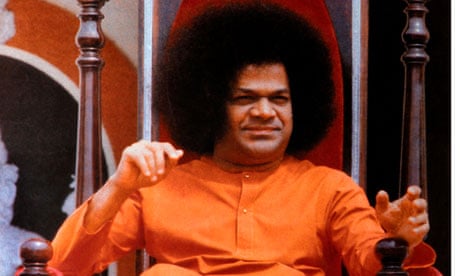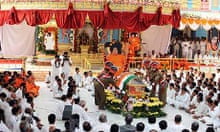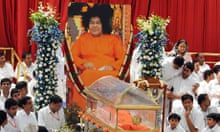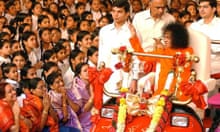Sai Baba, who has died of heart failure aged 84, was the most influential and richest in India's long line of spiritual teachers claiming supernatural insight and powers. The foundation centred on his ashram in his native village, Puttaparthi, thought to be worth £5bn and perhaps much more, is devoted to building and maintaining schools, hospitals and irrigation works with a reach far beyond his own state of Andhra Pradesh.
Attributing equal value to all faiths, formal or informal, Sai Baba reached across sectarian and cultural barriers to a following, in India and abroad, probably numbering tens of millions. The trust that manages the vast properties and religious affairs of the Sai Baba estate operates centres in 114 countries and claims followers in 178.
Sai Baba's simplicity of speech and manner, small stature – he stood just 5ft 2in tall – and massive afro hairstyle charmed and disarmed visitors of widely different ranks and cultures, including prime ministers, Bollywood stars and sporting celebrities.
Born Sathyanarayana Raju, Sai Baba came from a modest family in Puttaparthi, in what is now the southern state of Andhra Pradesh. His devotees' accounts of his childhood are filled with portents and omens, including reports of his especially charitable nature.
At the age of 14 he is said to have undergone a mystical transformation, after which he announced that he was the reincarnation of the Indian ascetic the Sai Baba of Shirdi, whose teachings contained elements of Hinduism and Islam, who was seen as a saint by members of both communities and who died in 1918. After his revelation to his family, Sai Baba began travelling in southern India, preaching, reportedly performing miracles and accumulating followers. Unlike other globetrotting Indian gurus who captured the western imagination in the 1960s, he did not travel abroad, apart from a trip to Uganda and Kenya in 1968.
In his early career, Sai Baba inspired awe among his devotees by performing seeming miracles, such as producing vibhuti (holy ash) and items including watches, gold chains and rings out of thin air. But he abandoned such gimmicks after they drew ridicule.
Puttaparthi, where his ashram was built in 1950, was gradually transformed into a booming global pilgrimage centre, drawing visitors from across India and around the world. Along with upmarket hotels and restaurants serving an array of international cuisines, Puttaparthi now has its own airstrip for the convenience of the VIPs and affluent devotees who flocked for guidance to India's most famous living religious figure.
There is also an institute of higher medical services and Sri Sathya Sai University, providing quality healthcare and education free for deserving students. A 330-bed super-speciality hospital near Bangalore, opened in 1991, is run by his foundation's central trust. A new Vidya Vahini scheme, launched in November, aims to aid grassroots education. The crowning achievement of the foundation's charitable work was its funding for the renovation of the Kandaleru-Poondi canal to carry drinking water more than 100 miles to Chennai (formerly Madras) city at a cost of £1bn. This and other projects brought clean water to almost two million people in various drought-prone areas of southern India.
Some years ago Sai Baba's reputation was marred by allegations by western pilgrims of sexual abuse. These were never formally investigated and failed to dent the holy man's popularity. A 2004 BBC television programme called the Secret Swami featured interviews with at least two American male devotees who claimed the guru had exposed himself to them while claiming it was part of a healing ritual. Sai Baba dismissed the sex abuse allegations as false and described them as the "cawing of crows".
In 1993, several people were killed in a scuffle in Sai Baba's living quarters, apparently a conflict between devotees over who deserved closer proximity to his holy presence. But there was – and perhaps still will be – conflict over the management of the ashram's vast income. Sai Baba has not named a successor. He was never married and had no children.




